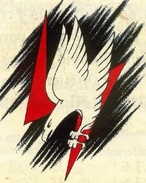In the year one thousand nine hundred and forty three, the thirteenth August at two forty five in the morning, a damaged aircraft was shot down in flames by a German fighter over the territory of La Bussière at an isolated spot called Le Bois de Courtépée. The Fire and Rescue Service, under instruction of the Town Hall went to the site to recover the bodies of the aircrew. They were aided by a few volunteers. The plane was litteraly broken to pieces but the search revealed an identification plate marked as follows : Stirling Sérial N° SB 38807 .S DRG 60/ N° 4294000 1SS23 Sir MS Inspect.CO 182 Proper identification of bodies was almost impossible. At the center of the wreck was a badly burned body at the side of which a metal ring and fragments of a letter were found. A few words were readable, Jacques St James London. The body was put in coffin number 1. At the controls was a partial body bearing rank emblems. From the torn shreds of clothing a cigarette case was found with the inscription CoDoung-From-Nan-Ein and on a scrap of paper the name Harris was visible. The body was placed in coffin number 2. On the right was a disfigured body on which the name Rose as well as the service number 165-42 could be seen. The body was placed in a coffin marked l’X in which were placed partial bodies of other airmen. In coffin Number 4 were placed all body and flesh parts found around the site and in particular, two heads of which one appeared to have two bullet wouds. This operation commenced at 14 H and finished around 20 H after having scrupulously searched the area on a radius of 200 meters. The search was particularly difficult due to the thick brushwood. La Bussière, the same day, at 22 H, the bodies were taken to the Town Hall. These operations were effected in the presence of us, M. E. Maire de la Bussière-sur-Ouche and under the direction of us, P.L., Lieutenant Commandant la Subdivision of the Fire and Rescue Service. The funeral took place at 17 H on the 14th August, attended by a very large crowd who wished to take part in the procession to the cemetery and to accompany the victims to their last resting place. In spite of protests from German troops, the coffins were laid to rest under hundreds of flowers, bouquets and four beautiful wreaths one of which was from the local veterans. Here is presented the ring and cigarette case and some damaged bank notes that survived the fire and found scattered on the site as well as the Indentification Plate of the aircraft and a small piece of torn flag. All these effects were transferred to the local Red Cross representative. Herewith is signed this official report.
|
|
The reading of this report and the description of the horrendous injuries
to the airmen evoke great and strong emotions that are only equalled in
the knowledge that such a high sacrifice is the price of our new found liberty. If your travels bring you to La Bussière-sur-Ouche, go to the village cemetery to honour the memory of these seven young men who, amongst so many others, deserve a few moments of silent reflection. Note : The plane crash was reported through a secret radio agent based in the Dijon area, named « Bel » (Monsieur Michel Pichard) Officer BOA. (source BCRA & Mr Grandhay) |





